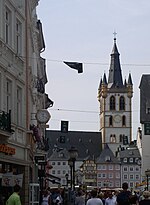Electorate of Trier

The Electorate of Trier (German: Kurfürstentum Trier or Kurtrier or Trèves) was an ecclesiastical principality of the Holy Roman Empire that existed from the end of the 9th to the early 19th century. It was the temporal possession of the prince-archbishop of Trier (Erzbistum Trier) who was, ex officio, a prince-elector of the empire. The other ecclesiastical electors were the electors of Cologne and Mainz. The capital of the electorate was Trier; from the 16th century onward, the main residence of the Elector was in Koblenz. The electorate was secularized in 1803 in the course of the German mediatisation. The Elector of Trier, in his capacity as archbishop, also administered the Archdiocese of Trier, whose territory did not correspond to the electorate (see map below).
Excerpt from the Wikipedia article Electorate of Trier (License: CC BY-SA 3.0, Authors, Images).Electorate of Trier
Laufrunde Moselstadion, Trier Nord (Nord)
Geographical coordinates (GPS) Address Nearby Places Show on map
Geographical coordinates (GPS)
| Latitude | Longitude |
|---|---|
| N 49.766666666667 ° | E 6.65 ° |
Address
Laufrunde Moselstadion
Laufrunde Moselstadion
54292 Trier, Nord (Nord)
Rhineland-Palatinate, Germany
Open on Google Maps










